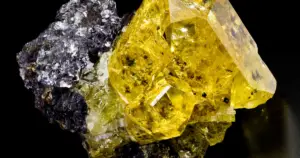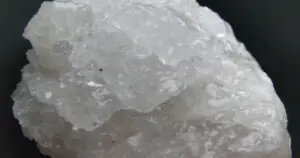Sphene Meaning: Healing Properties, Benefits and Uses
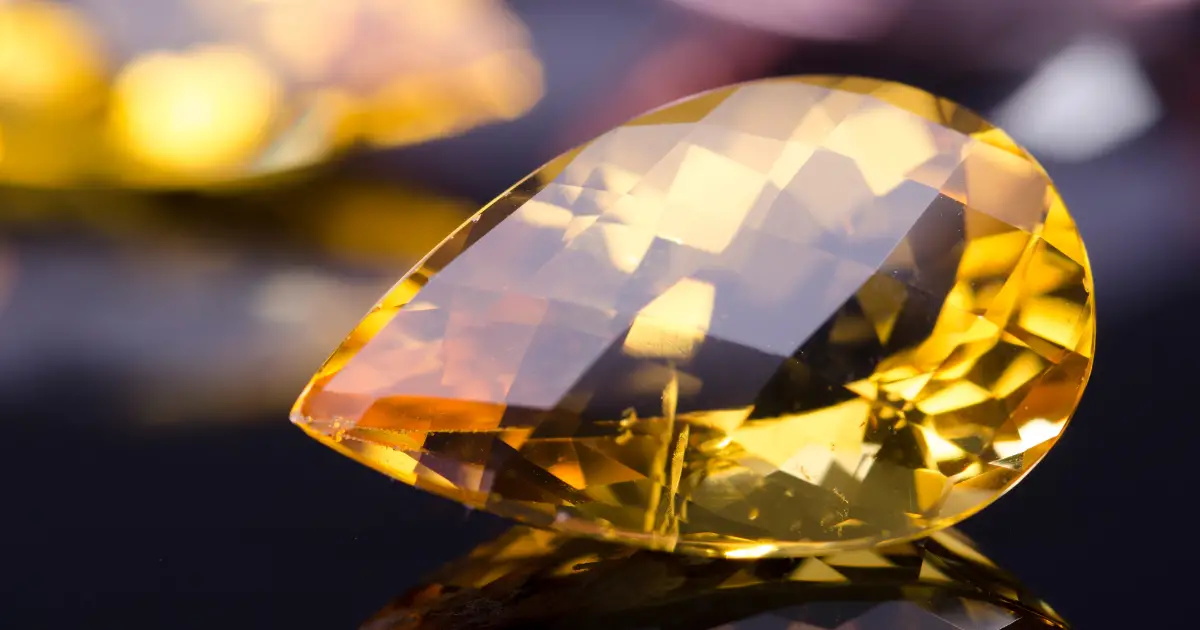
Sphene, also known as Titanite by mineralogists, is a magnificent gemstone sought by collectors for its high dispersion and diamond-like shine. It is one of those wonderful gems that may truly mesmerise you with the best-faceted specimens flashing three different hues and exhibiting brilliant fire.
Sphene has long been valued, mostly for the amount of fire it contains, but its rarity has kept it from gaining widespread recognition. But when new sources for the stone are discovered, we are seeing it on the market more frequently.
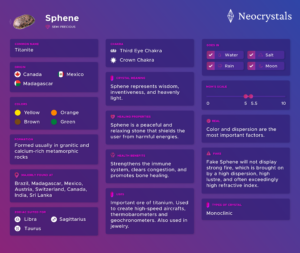
Table of Contents
What is Sphene?

Titanium mineral known as titanite, also called sphene, is a rare gemstone prized by collectors for possessing a multicoloured glitter that surpasses that of diamonds and a shine that is slightly below the diamond. It is a semi-precious stone which is rated between 5-5.5 on the Mohs scale of hardness.
The gemstone usually has many gradations between its yellow, orange, brown, and green hues and frequently exhibit colour zoning and can be colourless or black. However, turn the stone in the light to see multiple hues and sparkling rainbow glitter.
Lighter colours, especially yellows, mild oranges, and greens, which best display the gemstone’s remarkable dispersion, are preferred by consumers, according to IGS. The most desirable variety is “chrome sphene,” which is dark green in colour and has a colour similar to a fine emerald, according to IGS.
How to identify a Sphene?
Sphene can be identified by its physical properties like color and dispersion. The most prevalent sphene colours are yellow-green, green, and brown, with green being the least common.
It can be recognised by its strong fire, which is brought on by a high dispersion, high lustre, and often exceedingly high refractive index. The ability of a mineral to divide white light into spectral colours is referred to as dispersion, and sphene has one of the largest dispersions of any material.
The sphene has a 0.051 dispersion. In contrast, the dispersion of a diamond is 0.044. Although sphene and zircon have similar refractive indices, sphene can be recognised from zircon by its lower Mohs hardness rating of 5 to 5.5 as opposed to zircon’s higher Mohs hardness rating of 6.5 to 7.5.
Sphene Cuts and Shapes
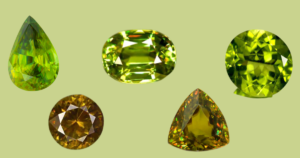
The sphene’s cut affects how well its dispersion displays, just like colour. Numerous faceted cuts are used to display sphene’s great dispersion and adamantine brilliance. Cutting it can be challenging because of its only moderate toughness. Fire is best displayed by brilliant faceted cuts like round or princess.
Shapes of sphene include octagons, trillions, squares, rounds, and more elaborate shapes like ovals, pears, and cushions. A cabochon cut is frequently used for transparent to opaque stones. Step cuts, like those used for emeralds, will also look stunning for darker or less clear stones but may be marginally less expensive. Translucent to opaque specimens are frequently turned into carvings, beads, or cabochons.
Where is Sphene Found?
Sphene can be found in granitic and calcium-rich metamorphic rocks as an accessory mineral. Similar to sphene, these metamorphic rocks have cavities, including gneisses, schists, granite, and some metamorphosed limestone.
Today’s sphene is mostly from Brazil and Madagascar, with a small amount also coming from Mexico, Austria and Switzerland. While Canada generates brown and black crystals, Madagascar produces green crystals, some of which are huge in size. India, Sri Lanka, Afghanistan, Germany, Kenya, Myanmar, Pakistan, Russia, New York state, and Minas Gerais, Brazil are other locations where sphene has been discovered.
Sphene Stone Meaning
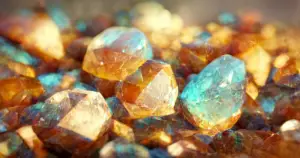
The name “sphene” is derived from the Greek word “sphenos,” which means “wedge,” and alludes to the mineral’s distinctive wedge-shaped crystals. However, it also goes by the term titanite, which refers to its position within the mineral family.
Although frequent publications and books first identify the mineral using both names, the International Mineralogical Association Commission on New Minerals and Mineral Names (CNMMN) adopted the term titanite and “discredited” the name sphene as of 1982.
The word ‘titanite’ alludes to titanium’s presence. Whereas, ‘sphene’ represents wisdom, inventiveness, and heavenly light. For mediums, astrologers, and tarot readers, the spiritual sphene gemstone serves as a talisman.
Additionally, it is pleochroic, displaying multiple colours depending on the viewing angle; transparent sphene specimens are noteworthy for their trichroism, which displays three colours. Sphene represents knowledge, invention, and divine light. The three colours vary depending on the base stone colour. Gemologists favour ‘sphene’, whereas mineralogists typically prefer ‘titanite’.
Sphene Meaning in Ancient Lore and History
In 1787, Swiss scientist Marc-Auguste Pictet made the first titanite discovery near Germany’s Bavarian Forest. However, it wasn’t until German scientist Martin Klaproth named and described the stone for the first time in 1795. He decided to name titanium after the Titans, sons of the Earth when he discovered another new element. Rene Hauy, a renowned French mineralogist, coined the term “sphene” in 1801. Both words gained popularity, but “sphene” was more generally used.
The mineral was said to have mystical properties in ancient Egypt. In order to safeguard them from any calamities, the Egyptians decked their sacred cats with collars that contained sphene. Priests in the revered temple of the god Ra, the sun god, also wore this stone as an amulet. It appeared to be retaining a portion of the sun deity Ra because of the way he shone brilliantly in the sunshine.
Sphene Crystal Properties
Sphene is a peaceful, relaxing stone that shields the user from harmful energies. Sphene’s vibration will mentally energise you and could improve your creative ability. It will speed up your learning process and aid in the assimilation of new information. It is frequently advised to take sphene stones, which are said to help improve focus, memory, and information processing.
It will promote cerebral activity and has a strong vibration inside the third eye chakra. It is beneficial to employ in meditation because it resonates with the ethereal golden ray of Christ’s consciousness within the crown chakra. Sphene’s meditation raises consciousness and opens doors to the wisdom of the universe and other dimensions. To access and recollect past and future life consciousness, use sphene.
Sphene Healing Properties
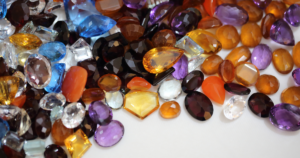
Based on their hue, energy, and past, gems offer particular healing properties. Sphene and other green gemstones are utilized for connecting with nature. It has a good healing effect and stimulates the solar plexus as most yellow-green stones do. It is very useful for helping you become more organised. For those with mental health issues, this gemstone is highly helpful. Additionally, it shields against and even heals bone illnesses.
Physical Healing
More specifically, it keeps the bones from deteriorating. The muscles remain strong and healthy because of this. Physically, sphene is thought to relieve tissue inflammation, fever, and muscle pain.
Blood problems are treatable with sphene. The immune system might benefit from sphene. Skeletal problems may be treated with sphene. Pain in the muscles could be treated with sphene. It resolves dental issues. Even better, it fortifies the wearer’s entire immune system, making them less susceptible to illness. It is thought that wearing this stone encourages the body to produce more red blood cells. It keeps the ratio of red to white blood cells in check. It regulates body temperature and guards against all skin conditions.
According to popular belief, green sphene improves vision. Additionally, it has the ability to treat headaches and migraines brought on by cerebral vascular spasms.
Emotional Healing
Sphene is thought to aid in emotional processing, mental organisation, and emotional balance. It encourages mental agility and can help with the development of knowledge in tarot, numerology, and other oracle specialities. You will benefit from using this crystal in meditation in a variety of ways, making it a potent tool.
It is claimed to increase your intuition and is known for its ability to support clairvoyant powers. Sphene will increase brain activity and help you take in new knowledge because of its potent third-eye chakra function.
Sphene Metaphysical Properties
Sphene improves one’s capacity for mental and focused effort. It also brings prosperity. It broadens our knowledge. It also achieves knowledge of the soul and self-realization. At the same time, positive energy is given to a person by this stone.
In order to work toward and accomplish his goals, a person might benefit from sphene by improving his mental faculties. It assists someone in realising their dreams. It is also ideal for someone seeking prominence. It motivates someone to take the appropriate steps to realise their objectives. Additionally, it enhances one’s financial situation. By donning this gemstone, one becomes self-reliant and endowed with leadership abilities.
Sphene Benefits
This stone will benefit you in a variety of ways, including:
- By strongly stimulating the third eye chakra, it will assist your body to heal a multitude of physical health issues, including those affecting your vision and hearing.
- It is also a powerful stone to aid organisational abilities. If you work in a position of authority, this stone will aid you in organising your coworkers. This might enable you to accomplish your goals more quickly.
- Witches, sorcerers, and mediums highly value the magical qualities of sphene. They need it to learn new spells and skills and cannot function without it.
- It may assist you in bringing your goals and life dreams into reality by stimulating your brain faculties.
Sphene Benefits Spirituality
Your spiritual growth and understanding can also benefit from sphene by your enhanced visionary powers. These visions may help you understand more about the problems that are causing you problems if you want to learn more about your previous life. This stone has a vibration that works with your head chakra to help you advance spiritually, a great stone which can enhance your psychic talents.
The sphene vibration will sharpen your mind, support your creativity, and greatly assist you in being more organised. It has good therapeutic properties, stimulates the solar plexus like other yellow-green stones, and helps you manifest more money.
Sphene & Feng Shui
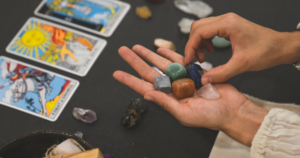
In order to get the maximum benefits, sphene can be placed in your workspace or at your home. It is ideal to use it while meditating and it can be used as jewelry also. Although this is a rare gem, portions of it make lovely jewellery. The best place to wear Sphene jewellery, if you can get some, is on your ears since doing so maintains the energy close to your third eye. You might also benefit from maintaining a piece of titanite in your auric field by wearing a pendant made of this stone, which is also quite effective.
Sphene Birthstone
This stone is regarded as very adaptable by astrologers. Any zodiac sign can wear it. Whatever your element, it will support excellent deeds and serve as a defence against envious people.
Yet, it can be used as a 16th wedding anniversary or an August birthstone as a replacement for peridot. It is also believed to benefit Libra, Sagittarius, and Taurus a little more.
Sphene Chakra
The crown chakra and third eye are stimulated by sphene. The Ajna chakra, also called the third eye or brow chakra is related to the mind and past lives, according to traditional Hindu belief systems. Your ability to develop intuition is strongly aided by the vibration of titanium at the third eye. This chakra also houses the pineal gland, which is related to the emergence of psychic powers.
The Anahat Chakra, which impacts compassion, empathy, selflessness, and devotion, is kept under control by this gemstone. It also regulates the body’s Aagya Chakra and aids in improving a person’s mental faculties.
What are the Uses of Sphene?
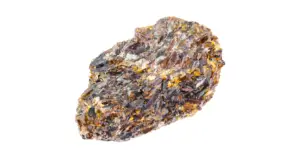
Other than being used for its healing properties and metaphysical properties as a gemstone, sphene is also used in jewelry. At the same time, since it is a titanium mineral, it is utilized to create high-speed aircraft because of its extremely high melting point. Also, as a source of titanium dioxide for colours, titanite can be mined. Additionally, scientists employ titanites as thermobarometers and geochronometers, which are devices for detecting the geological past through radioactive decay.
Caring for Sphene

Sphene should only be cleaned using a gentle brush bathed in warm water with light soap. Avoid using ultrasonic technology since it is susceptible to heat, which could change its color, and chemicals. Simply removing dust from a sphene gemstone could result in scratches because home dust contains quartz, which has a hardness of 7 on the Mohs scale. So, care should be taken to keep it safe from harm.
The stone must be guarded against collisions, scratches, heat, acids, and perspiration. Ultrasonic or mechanical cleaning methods should never be used on them. Keep this gemstone away from chemicals, hot water, and high winds to keep it safe.
Due to its delicate qualities, it can crack with the smallest amount of percussion. Resultingly, one needs to use it extremely carefully. Sharp items need to be kept away from it. Additionally, avoid heat, acids, excessive sweating, and hard impacts when using sphene.
Additionally, Before indulging in strenuous physical activity, such as sports, cleaning, or exercise, always take off any jewellery or gemstones. Sphene should be preserved separately from other gemstones because it is readily scratched by harsher materials. It is advisable to enclose this gemstone in soft material or set them within a jewellery box lined with fabric.
When to Cleanse Sphene?
The sphene gemstone should be cleansed periodically because it frequently comes into contact with many different energies. In order to ensure that there is no negative energy present, it is crucial to clean it both before and after each use.
How to Recharge Your Sphene?
You should keep your gemstones cleansed and charged, just like all other crystals and priceless energy jewels, so that it is always prepared to offer a helping hand. One spiritual technique for recharging your stone is to place it in the light of a full moon. It can also be smudged with your preferred spiritual smudging fragrance; sage is an excellent option for deep purification.
Sphene Activation Process
The sapphire needs to be cleaned with a delicate, clean cloth before being put in a neat dish. To energise and activate the gemstone, repeat a holy prayer of your choice a few times. After saying the sacred mantra, remove the stone or jewellery from the bowl, wash it with purified water, and then put it on.
How much is Sphene worth?
The most costly ones are faceted sphenes with intense colour, good dispersion, and average clarity. The cost of titanium or sphene per carat can range from INR 7,000 ($ 95) to INR 20,000 ($ 275) depending on the quality characteristics.
What determines Sphene’s price and value?
The most significant value elements for this gemstone, as with many others, are colour, clarity, and carat, followed by the cutting technique and artistry displayed.
The best prices are typically obtained for specimens with fair to good clarity, vibrant and appealing body colour, and at least some indication of dispersion. Lighter hues, particularly yellows, bright oranges, and greens, are preferred because they best showcase sphene’s superb dispersion. Heat treatment is used to turn some sphenes red or orange. Treatment frequently reduces value.
Does Sphene make a good jewelry stone?
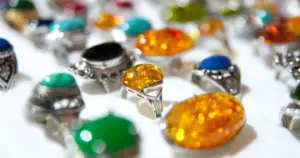
Sphene is a beautiful gemstone thanks to its high refractive index, dispersion, and shine. However, because it is a rare gemstone, jewellery rarely uses it. Furthermore, because sphene lacks toughness, it is not advised to be worn frequently in rings or other jewellery that will be subject to everyday wear and tear. But, if set in a protective setting and used sparingly, sphene gemstone can make stunning jewellery. Care must be taken when mounting it because rings could become damaged.
Sphene is best utilised for jewellery that is less likely to sustain serious bumps and dings, like sphene earrings or pendants, which are not nearly as likely to sustain damage as rings or bracelets. The finest settings for sphene in rings and bracelets are secure ones, including bezel settings. Beautiful earrings, pendants, and brooches can be made using sphene gemstones.
Sphene Real vs Fake
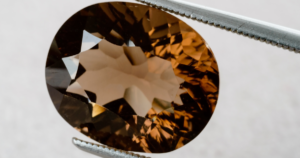
Qualities like dispersion which is among the highest of any mineral, even exceeding that of a diamond can help in spotting a real gemstone. Under the microscope, its strong birefringence and refractive index result in a distinctive high relief, which, along with the mineral’s typical yellow-brown colour and lozenge-shaped cross-section, makes it easy to differentiate.
Colored cubic zirconia (CZ) has great dispersion and brilliance, making it a convincing sphene imitator. But CZ is harder than sphene and lacks its birefringence. Sphene does not fluoresce in UV light, but CZ does so this makes it easier to distinguish.
FAQs
Is Sphene a real gemstone?
Yes, sphene is the only member of the titanite mineral family that is regularly used as a gemstone. It is a rare, semi-precious gemstone.
Is titanite the same as Sphene?
Yes, titanite is also known as sphene. Gemologists favour ‘sphene’, whereas mineralogists typically prefer ‘titanite’. However, in 1982, the term spend was discredited but it is still used as an informal name.
What kind of stone is a Sphene?
Due to its titanium content, sphene is an extremely rare dazzling yellowish-green, green, orange, or brown gemstone with a high lustre.
What is Titanite worth?
The price of titanium or sphene per carat can range from INR 7,000 ($ 95) to INR 20,000 ($ 275) depending on the quality characteristics like color, size and lustre etc.
Where is Titanite most commonly found?
The main suppliers of this gemstone are Canada, Madagascar, and Mexico. Gemmy crystals up to 4 inches long are produced in Mexico. Madagascar generates occasionally huge green crystals. Crystals in brown and black are made in Canada.
What color Sphene is most valuable?
The rarest and most expensive sphene is chrome. Green, yellow, and light orange are examples of lighter colours that will typically be more valuable than even rich hues since they best show the stone’s dispersion.

